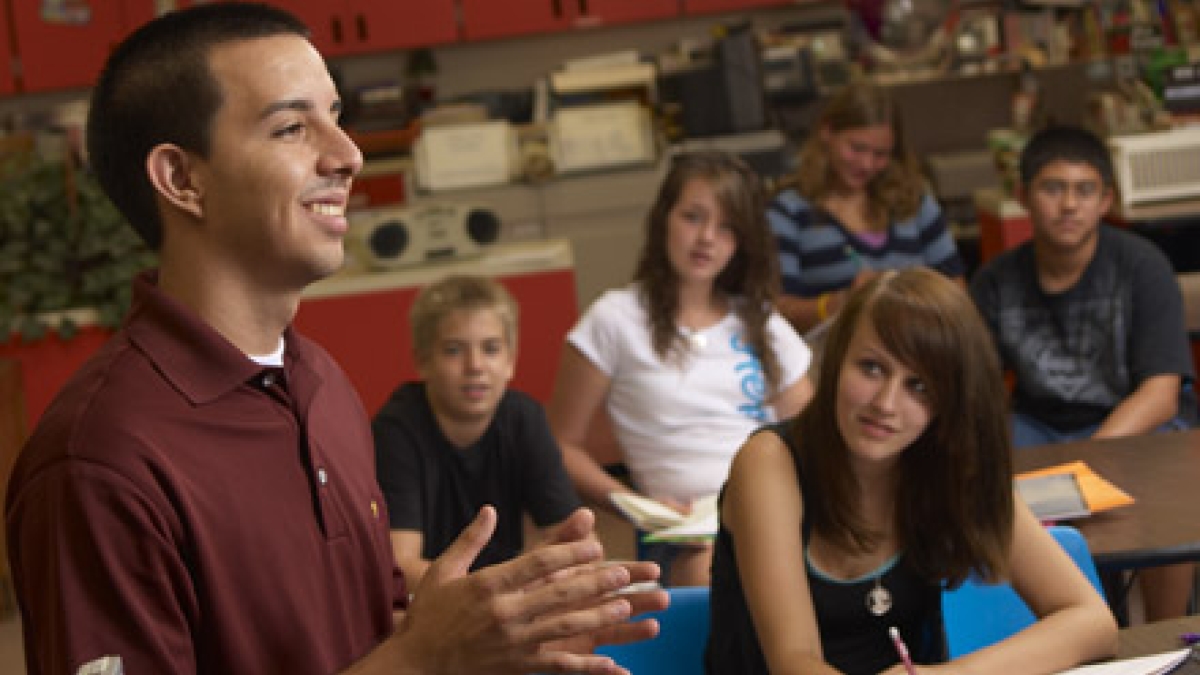ASU adds new routes for students to enter teaching career

Arizona State University is gearing up to produce more and better-prepared school teachers, addressing a critical need in classrooms around the state. In fall 2013, ASU will offer a new certification program and several new bachelor’s degrees that can lead directly to a teaching career.
The new programs will allow students to take more courses in their major field, while offering training in the methods and practice of teaching and also field placements in local schools. Students’ degrees will be in content areas such as mathematics, physics, English and history, allowing deeper mastery of a subject. But they’ll be equipped to handle the challenges of a high school classroom.
The Mary Lou Fulton Teachers College has worked closely with other ASU colleges and with the Arizona Department of Education to roll out the new pathways to teaching careers. Students have asked for them, as many realize by their sophomore year that they’d like to be teachers, but they’re reluctant to switch majors.
“We need as many routes to a teaching career as possible,” says Elizabeth Hinde, associate professor in the Teachers College and director of the division of teacher preparation. “There’s a lot of interest in this, among students and in the colleges. Momentum has been building over the past several years, and Teachers College is collaborating with other ASU colleges to prepare more teachers than they currently do, especially in areas of critical need.”
Currently a bachelor’s degree with high school teaching certification is available only through the Teachers College, as a major in secondary education with a concentration in a content area. Math and science majors in the College of Liberal Arts and Sciences, for instance, must return for post-graduate work in order to be certified.
Because of the teacher shortage, particularly in math and science, many middle- and high-school teachers are working outside their strengths, teaching subjects in which they have little background.
The new undergraduate certificate for secondary education that leads to teacher certification already has about 45 students who plan to enroll, though it was just launched in February. It is a university certificate, making them eligible for state certification. The program may require students to take more than 120 credit hours to graduate.
“It’s an absolute advantage for students, as it allows them to pursue a content area as a major and to add this certification before they graduate,” says Erica Mitchell, director of undergraduate services for Teachers College. “They will be well prepared, and highly qualified and marketable to school districts.”
Many students majoring in history, English and math begin searching for a career path in sophomore or junior year, she says. Some have always wanted to teach. The new program will provide a way for them to stay within their majors, yet be certified to teach by the time they graduate.
“We’re especially targeting high achieving students who entered ASU as freshmen with many credit hours completed, and who have four-year scholarships,” says Mitchell. “This is a great option for them.”
Students in any major which allows a number of electives can enroll in the program, as long as they don’t wait too late in their college career to sign up.
In a true partnership, Teachers College also has worked with units in the College of Liberal Arts and Sciences (CLAS) to design four new bachelor’s degrees: a B.S. in mathematics with a concentration in secondary education, a B.A. in history with a secondary education certificate, a B.S. in physics with a concentration in secondary education, and a B.A. in English with a concentration in secondary education.
With an especially critical shortage of math teachers in public schools, faculty in ASU’s School of Mathematics and Statistical Sciences have hoped for years for such a program. The new Common Core State Standards for Mathematics, in which more seventh and eighth graders study algebra and many high schoolers are led into calculus, add an extra push for putting math majors as teachers in high school classrooms.
Fabio Milner, professor of mathematics and director of mathematics for STEM education, says there’s been a great deal of interest among students. Still, creating a new major has not been easy.
“We had to create several new courses in both content and pedagogy, staying within 120 hours,” he says. “It’s been tricky. But we’ve worked with Teachers College to come up with a very well balanced program. We want to produce expert mathematicians who have the preparation to be excellent teachers, to meet the needs of the future.”
Milner also has worked with Teachers College to beef up the math content for students working toward a B.A. in elementary education, helping create four new content courses.
History faculty in the School of Historical, Philosophical, and Religious Studies also have been working for years toward such a degree, hiring Lauren Harris in 2011 with a joint appointment as assistant professor of history education in both the Teachers College and CLAS. She is enthusiastic about the possibilities for the new program.
“This allows us to have more connections to the community, with field placements,” she says. “A great number of history majors eventually end up teaching, and this gives them better preparation, as trained teachers who also have taken more history classes. There’s been a lot of support for this at ASU.”
The new physics degree program is part of the Physics Teacher Education Coalition, funded by the American Physical Society and the American Association of Physics Teachers. Currently two-thirds of high school physics teachers lack a major or a minor in physics, according to Robert Culbertson, associate professor of physics who has helped develop the new program.